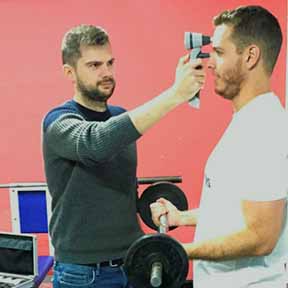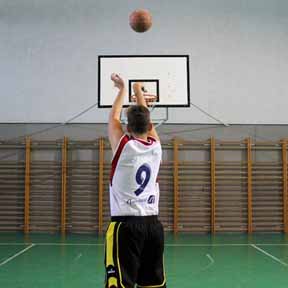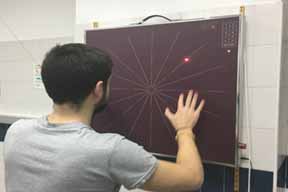Physical exercise and the visual system
There is evidence that physical exercise plays a crucial role in the human health status. Regarding the visual system, physical exercise has demonstrated to induce acute changes in the ocular physiology and visual function, although they rapidly recover to baseline levels after exercise cessation. For this reason, this research group is interested in investigating the association between sport practice and the eye, and aims to explore the influence of physical activity in both ocular health and visual performance. To do so, we count on the collaboration of experts in the field of sport science.





- Ocular health and exercise. This research group is mainly concerned about intraocular pressure, given that it is the only clinically treatable factor for the prevention and treatment of glaucoma disease. With this ocular condition being the leading cause of irreversible visual loss worldwide. In this sense, we have conducted several studies to determine the impact of exercise on intraocular pressure, aiming to improve the management and prevention of glaucoma through lifestyle interventions. Also, we are interested in analyzing the short- and long-term effects of different physical programs on the eye physiology.
- Visual function and exercise. CLARO group aims to test the visual abilities required to succeed in different sport disciplines that are visually and cognitively demanding in order to determine whether different visual interventions may permit to enhance sports performance. Also, we are interested in testing the impact of physical and mental demands during exercise practice on the visual function, and how it may affect sport performance.
Analysis of the accommodative function
Ocular accommodation mechanism provides clear vision at different viewing distances and ensures optimal visual performance in daily activities. Accommodation is primarily stimulated by alterations in the retinal image, as well as by task demands with a behavioral component caused by changes in the autonomic balance of the subject. This research group has a great deal of experience in the study of the accommodative function in laboratory and clinical settings when manipulating the individuals´ state (e.g., mental demand, caffeine intake), as well as when including clinical populations such as children with attention-deficit/hyperactivity disorder.


- Effects of optical and non-optical factors. Accommodation is mainly driven by optical factors, but also by non-optical factors (e.g., arousal state, attention, highly demanding physical or mental activities, etc.) since ocular accommodation is controlled by the action of the ciliary muscle which is innervated by the autonomic nervous system. This research group aims to gain understanding about the underlying mechanisms that regulate the accommodative response in order to test ocular accommodation as a potential biomarker of the autonomic state. In addition, we seek to evaluate the cross-linked reciprocal interaction between both accommodation and vergence mechanisms.
- Clinical populations. The eyes are considered a prolongation of the central nervous system and the ocular system has demonstrated to reflect many neurological alterations. Our research group has focused on the study of the accommodative function in two neurological alterations with a high incidence, namely attention-deficit/hyperactivity disorder, and multiple sclerosis. We are mainly interested in exploring the possibility of including the dynamics of ocular accommodation in combination with neuropsychological tests for enhancing the diagnosis and management of both conditions.
- Myopia progression. Myopia is the commonest refractive defect, and its prevalence and incidence are increasing considerably in the last years. Some authors agree that an inaccurate accommodative response and facility may be associated with the progression of myopia. Therefore, we aim to characterize the accommodative function of myopes as well as to study the accommodative behavior under different optical strategies in order to clarify its role on myopia progression.
Development of clinical tools
The visual function can be assessed by different procedures including subjective and objective techniques. Although subjective methods are most used in clinical settings, objective methods have shown to provide a more reliable and accurate measure of most visual parameters. CLARO group is interested in developing and incorporating objective methods in clinical practice to ensure an accurate and reliable measure of the visual state of the patient, and also to design protocols that enable to monitor the visual function under different experimental conditions.
- Accommodative facility test. Accommodative facility is a clinical test used to evaluate the ability to alter accommodation rapidly and accurately. The clinical standard method consists in changing the accommodation level with the use of a lens flipper (usually ± 2.00 D), however, this method presents some limitations due to the subjectivity of the response. Our research group has developed a patent pending method that allows to accurately assess the frequency and precision of accommodative facility.
- Evaluation of accommodative and binocular anomalies. This research group has designed a tool to assess both the accommodative and binocular system in a dynamic and real-life scenario by incorporating an autorefractometer and eye-tracker while a dynamic target moves around patient’s visual field.
Ocular physiology
The ocular system suffers from morphological, biochemical, and functional changes or adjustments under the influence of several stimuli (e.g., physiological, mechanical and pharmacological factors). Being aware of these changes is especially relevant when the inclusion of stable measures of ocular physiology is required, including for the diagnosis and management of different eye diseases. This research group has been focused on the evaluation of topographic, tomographic, and biomechanical changes of the anterior eye segment in special populations and under different experimental conditions.
- Special populations and ocular physiology. There exist several disorders that present an altered cornea. Our research group is interested in the study of physiological fluctuations that occur in patients diagnosed with corneal ectasias, and patients diagnosed with multiple sclerosis due to the corneal thinning and bulging, and reduction in total corneal nerve fibers density associated with each condition, respectively.
- External factors and ocular physiology. This research group seeks to determine how different factors such as diurnal variations, hormone cycle, drugs ingestion or topical instillation, physical exercise, and stress, among others alter the ocular physiology.
To assess the efficacy of controversial clinical procedures in optometry.
There is a lack of scientific evidence supporting the implementation of some clinical procedures in optometric practice. CLARO group aims to investigate whether these non-scientifically proven treatments or products (e.g., syntonic phototherapy or blue-blocking filters), which are, in some cases, supported by professional associations, have any positive effect on the visual function or ocular health.

